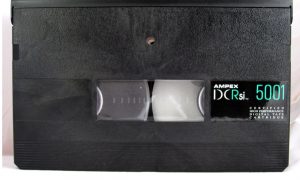History (1984): Software Increases Magnetic Areal Density
With PRML first used by Ampex for tape then IBM for HDD
This is a Press Release edited by StorageNewsletter.com on May 11, 2018 at 2:29 pmThis article comes from the Computer History Museum.
1984: Software increases hardware areal density
PRML techniques enhance magnetic media storage capacity
Ampex DCRsi cassette

(Ampex Corporation)
The most visible storage advances have been accomplished through innovations in recording media and electronic and mechanical hardware.
Each new generation has been supported by software programs that maximized the efficiency of these developments. One technique that increases areal density (the quantity of data stored in a given physical area) is PRML (Partial Response Maximum Likelihood) detection.
PRML is a method for converting a weak analog signal detected by the head of a magnetic disk or tape drive into a usable digital signal. It employs sophisticated digital signal sampling, processing and detection algorithms to manipulate the analog waveform (the ‘partial response’) and then determine the most likely sequence of bits this represents (‘maximum likelihood”).
PRML and its successor, EPRML, allow areal densities to be increased by 30-40% compared to earlier signal detection methods.
Ampex applied PRML to magnetic tape media in 1984 on the DCRS Digital Cartridge Recording System. For two decades, the DCRS was the de-facto standard for video and high-data rate instrumentation recording in flight-test and military airborne mission applications.
The IBM 0681 disk drive developed at the Hursley UK laboratory under the code name ‘Redwing’, with software from a team led by Gottfried Ungerboeck at IBM in Zurich, is believed to be the first use of PRML in combination with ferrite heads and film disks.
Shipped in 1990, Redwing offered a capacity of 471MB formatted (8 disks) with an areal density of 45Mb/square inch.
All HDD suppliers adopted PRML by 2000.
Other significant software developments that have improved the density, performance, and reliability of storage equipment, include innovative compression, signal processing and encoding techniques such as RLL (Run-Length Limiting), signal dependent correlation-sensitive sequence detection, LDPC (Low-Density Parity Checking), and ECC (Error Correction) codes.














 Subscribe to our free daily newsletter
Subscribe to our free daily newsletter

